QuestionTo Maggie,
I am thinking of buying a cockatiel, but i want one from young. I was just wondering if you could help me by telling me what is the best age to get on? and how can you tell how young a baby cockatiel is?
thanks, could you email me back on my email address please.
This information would be very helpful to me.
Thanks again,
Kate
AnswerHi Kate,
You didn't leave your e-mail address, so I couldn't e-mail this response to you directly like you asked.
If you are looking to purchase a baby cockatiel, make sure you get one that is fully weaned and has been eating solid foods exclusively for at least 1 week (while still maintaining his/her weight). Usually this means you will be looking for a baby cockatiel that is at least 10 to 12 weeks old.
Here is a copy of an article by Catherine Quinones from www.parrothouse.com about buying an unweaned baby bird:
Buying & Selling Un-weaned Birds
This is another hotly-debated topic. An un-weaned bird has physical and emotional needs that are best met by an experienced bird breeder. Although intuition and sheer luck have helped some inexperienced new owners wean and rear a well-adjusted baby bird, others have not been so lucky. Hand feeding has certain risks attached. Inexperienced owners should not go at it alone. Conscientious breeders (the ones that care about the bird's future health and the customer's long-term satisfaction) do not sell un-weaned birds to inexperienced customers without also = offering extensive training/support. Although it is tempting to buy an un-weaned bird, in particular to get it away from a less-than-trustworthy vendor, one should remember that doing so is a vote of confidence for that seller's practices.
Here is more that she has to say on the subject:
DO NOT BUY an un-weaned bird unless you have adequate background on its care
Please read the information that follows and then make up your mind on the subject. When I first became aware that un-weaned birds could be purchased I thought hand-feeding one's own bird was a neat idea. As I researched the topic I came to realize the process is fraught with accidents waiting to happen. = Like the Romans said, "Caveat Emptor", buyer beware. Make your decisions based on facts, not on myths and marketing ploys.
Background information on hand-feeding
Parrots are hand-fed by humans (as opposed to being raised by the parents) because sometimes the parents reject the babies. In the pet trade, however, hand-feeding is done in order to make the baby bird become used to being handled by humans. Some parent-raised birds eventually become tame, but they often are skittish and less trusting than well-socialized, hand-fed babies. Often, breeders allow the parents to incubate the eggs and to feed the chicks for a few weeks, then the babies are removed from the nest and the breeder takes over all feeding and socialization. Some breeders artificially incubate all eggs produced by their breeding pairs. At least in some cases, this is done to maximize clutch size (as artificial incubation rules out accidental breakage of eggs by parents, for example). Apparently, hand-fed birds are less successful at breeding than are hand-raised birds, so take this into consideration if you are thinking of buying birds for breeding purposes.
First of all, let me give you a quick description of the early life of = a baby parrot. Eggs may be incubated by the parents, by surrogate parents (other species of parrot) or they may be artificially incubated. When the chick hatches, it is absolutely dependent on its parents (or human surrogate). The baby bird is not covered in feathers, nor is it capable of doing much (unlike the precocial chicks of ducks and chickens with which most people are familiar). The baby's eyes and sometimes ears may not be open (I mean, they literally will be sealed). The chick won't even = be capable of regulating its own body temperature. The baby is capable of requesting feedings, though, and the parents comply by regurgitating food into the chick's mouth. The breeder feeds the chick by using a manufactured (or home-made) formula, which is delivered to the chick in two general ways:
- by dribbling the food into the chick's mouth (using a spoon, cup or syringe). This process is time-consuming, but somewhat similar to what the parent birds would do during the natural feeding sequence.
- by pumping the food into the chick's crop (tummy) by using a syringe to which a tube is attached (tube goes down the chick's throat, food is delivered directly to the crop) . This process allows the feeding to proceed at a VERY fast rate; unless the breeder takes pains to compensate, the chicks will miss out on valuable interaction time with the feeder (some people go as far to propose that this de-personalized process is RESPONSIBLE for a lot = of behavioral problems later in life). Such lack of interaction could negate the main purpose of the hand-feeding process, which should aim at creating people-friendly, well-adjusted pets.
In the early stages, feedings may be necessary as often as every couple hours, around the clock. Throughout the hand-feeding stage, chicks need to be kept clean (they can get quite messy while feeding), and must be monitored regularly to verify they are comfortable and doing well. The brooders and equipment used in hand-feeding need to be sterilized. These are just a few of the reasons that explain why hand-fed birds are more expensive than parent-fed birds.
Regardless of the food-delivery method, the hand-feeding process is not simple: the formula must be prepared fresh before each feeding, and it must be heated up to a certain temperature, or the chick's willingness to eat it AND its ability to digest the food may be compromised. Extremely hygienic conditions should be kept = so as to avoid passing diseases to the chicks, or from one chick to the next. If the hand-feeder is not really adept, the food may go into the chick's lungs instead of into its digestive tract, and the chick may die by choking or from infections that arise from the improper delivery of food (called aspiration). If the hand-feeder doesn't know what behaviors are normal for chicks of a given age and species, he/she may fail to realize the chicks are not responding (meaning that the hand-feeder may not realize the chick is dehydrated, sick, too hot or too cold, losing weight or simply failing to thrive). If the food is too hot, the chick's crop may literally be seared, which can obviously cause lots of damage or death due to the trauma itself or to secondary infections. Basically, there ARE a lot of physical dangers to the chick when it is hand-fed by humans, and those dangers are maximized when the hand-feeder is inexperienced.
There are also psychological aspects to the hand-feeding process. The human must provide the chick with social interaction (such as would be provided by the parents and siblings) in order to = have the chick's emotional development progress normally. I am not aware of any research specifically describing the early emotional development in parrots. However, considering that they are highly intelligent, social animals, and that other such = species (e.g., dogs) do have critical periods in their early development upon which normal adult behaviors hinge, it is not far-fetched to suggest that parrots may be similar in this respect.
As time goes by, the chick becomes fully covered in feathers, its eyes and ears open up, and it begins to explore its surroundings. Eventually, its development progresses to the point when parents would be encouraging the chick to eat on its own. This is a transition period that can be difficult for the chick, and the process through which the chick becomes progressively more independent from its parents for sustenance is = called "weaning." A chick is considered to be weaned when it is capable of eating enough food on its own for at least 3 days in a row. The exact timing of this process varies with each individual, but is relatively constant within species. If the chick is not emotionally secure, it may revert to less mature behaviors and it may need supplemental feedings in order to maintain its weight (and the weaning process will have to be completed once again). This point of "nutritional independence" is not simply a physical marker, it's also a major psychological step in the bird's emotional development. While some birds seem to breeze right through = the weaning stage, others fight it and WHINE a lot, which can be a real trial for the hand-feeder.
Why buying unweaned chicks is a very bad idea in most cases
As you can see, the hand-feeding process is NOT simple and clear-cut, = it has physiological and psychological aspects that are often entwined. Many bird breeders and parrot behavior consultants feel that hand-feeding and the weaning process, as well as the socialization that takes place along with them, ARE CRITICAL IN PRODUCING A HEALTHY, EMOTIONALLY SECURE, WELL-SOCIALIZED bird. In so many words, they feel that a lot of behavioral problems seen in adult birds can be traced to screwed-up "chickhoods". In my opinion, only experienced individuals should take it upon themselves to hand-feed their pet bird, because the risks exist, and I believe becoming a new parrot owner is complicated enough without throwing in the responsibility of properly socializing and nurturing a baby bird. The new owner will have plenty of opportunity to interact and "bond" with the bird later on... it is during that time that the owner will train the bird to behave within reasonable limits.
While many people without previous experience have successfully completed the hand-feeding process, others have gone through very traumatic experiences that have resulted in emergency veterinary care for the chick, and some have lost their baby birds (and their monetary investment). The actions of vendors who sell unweaned chicks to inexperienced hand-feeders and then fail to monitor the chick's progress suggest they place more emphasis on profit than on the welfare of the bird. It likewise can be argued that customers who buy unweaned chicks are also financially minded and that they are accepting the risks along with the savings. The problem is that in far too many cases, vendors fail to educate the buyers on the risks of taking home an unweaned chick, which may leave us discussing the ethics (and = legality?) of false advertisement Some such vendors actively lie and say the chick is weaned when it isn't; others simply lie by = omission and don't accurately describe proper hand-feeding and weaning techniques. When I wrote the Bird Health FAQ and had it = reviewed by one of our bird vets, he commented that what he'd like to see was a FAQ on hand-feeding: obviously his practice treats a lot of unweaned chicks that are suffering at the hands of inexperienced owners. I have written this section to educate the buying public about these issues, so that they can make informed choices when choosing from whom to purchase a pet bird. = In particular, I want to address certain myths that unscrupulous breeders use to manipulate customers into purchasing unweaned birds.
Myths about hand-feeding abound. The most common one is that the new owner must hand-feed the bird or otherwise the bird won't adequately "bond" to the new owner. This is an utter lie, as has been proven again and again. Whatever bonds the chick forges with the parents (or hand-feeders) will CHANGE when the chick reaches independence. At that point, the young parrot will also make new alliances among flock members and eventually perhaps with a mate. Therefore, the bird literally has built-in instructions to make new relationships through its lifetime. It's up to the owner to help develop that relationship, it doesn't magically appear by virtue of hand-feeding the bird. Besides, this "unique bonding through hand-feeding" mumbo-jumbo doesn't prepare the new owner for the period that = inevitably follows weaning, when the chick starts being "testy" as it develops its own ideas of who should rule the roost!
The second reason many new owners opt to buy an un-weaned bird is that such birds often sell for less than their fully-weaned counterparts. The difference is usually a few hundred dollars, and the closer to weaning the bird is, the higher the price will be. However, buying an un-weaned bird isn't always a bargain because if the owner accidentally hurts the bird during the feeding process, the breeder will not assume responsibility for that accident = if the sale had been finalized (which happens when the new owner takes the bird home). In contrast, if the person had a deposit or had paid for a chick that died or got ill while being hand-fed by the breeder, the breeder would be obligated to replace the bird or reimburse the customer. Furthermore, if one compares the price of an un-weaned chick sold at a pet store vs. the price of a fully weaned chick of the same species as sold by a breeder, one often discovers the breeder's price is as good if not better than the pet store price! This is because many pet stores buy un-weaned chicks and re-sell them, with the profits going to them and the price hike (and sometimes the responsibility for hand-feeding) being passed on to the customer.
I am very opposed to people with no experience hand-feeding chicks just because it "sounds like fun." I believe anyone who is interested in hand-feeding should apprentice with an experienced breeder, who has years of experience and yes, mistakes, upon which to draw. Anyone who wants to buy an un-weaned chick should educate him/herself on the process by reading about it AND by practicing under supervision. Once they start feeding their own chick on their own, they need to follow the same procedures that a quality breeder would have followed (weigh the bird daily, sterilize utensils, prepare fresh food for each feeding) and should remain in close communication with the breeder and/or a qualified veterinarian, who are best equipped to evaluate the chick's progress. Hand-feeding is a complex process, it is worth doing well. Anyone who wants to end up with a healthy, happy bird (as opposed to hiking the risk of a traumatized bird and/or a sick bird and/or a huge vet bill to correct hand-feeding mistakes) is best advised to get as much support as possible. If, after reading all of this, you still feel like buying an un-weaned chick, PLEASE make sure you are dealing with a decent, bird-loving breeder that will continue to supervise the chick's progress, and also have the chick's progress monitored by an avian veterinarian. Anything else is plain uncivilized!
Here are some articles with information on unweaned baby birds and why you should not be "sold" by a breeder to purchase an unweaned chick:
http://www.quakerville.com/qic/selling_unweaned.asp
http://www.itsagreysworld.com/misc/unweaned.htm
______________________
As far as telling the age of a baby cockatiel- this is a bit more tricky to describe. It is easy to tell very young cockatiels from adults (adults will have gone through at least one molt or two, so their feathers are usually brighter and sometimes change color- for example: male cockatiels develope bright orange cheek patches within 2 or three molts. Birds molt for the first time usually by 6 months and then continue to molt every 6 months (roughly) for the rest of their lives.
Some very young cockatiel babies will have black marks on their beaks. However, this coloration will disappear by the time they are 2 to 4 months of age. (So it is not always a good indicator of a birds age, because some baby birds might not have it). A breeder should know the exact hatchdate of all of his/her birds (that s/he has breed themself). Pet stores don't always know the age of their birds, and sometimes birds in pet stores are not recently weaned babies, but instead are juvinelle birds (6 months or so) or even adults.
I hope this helps.
Here are some other websites to check out with great information on birds and their care:
www.forthebirdsDVM.com
www.wingedwisdom.com
www.mickaboo.com
www.parrotchronicles.com
-Maggie

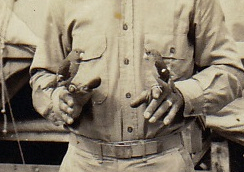 ID Birds
Question
Panama Birds
My uncle served in Panama in 1941
ID Birds
Question
Panama Birds
My uncle served in Panama in 1941
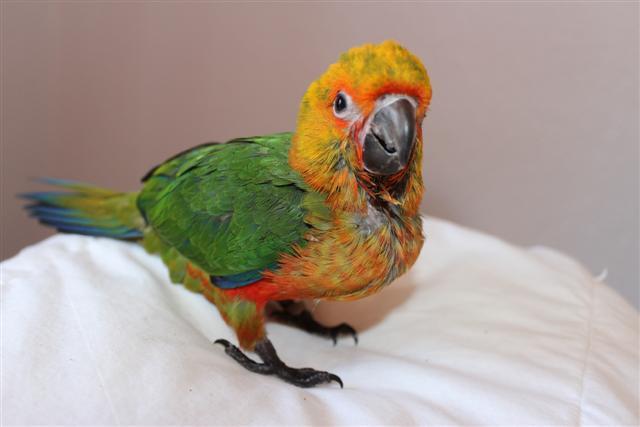 Jenday Conure Weaning?
Question
Castor the Conure
Hi
I have a 9 week o
Jenday Conure Weaning?
Question
Castor the Conure
Hi
I have a 9 week o
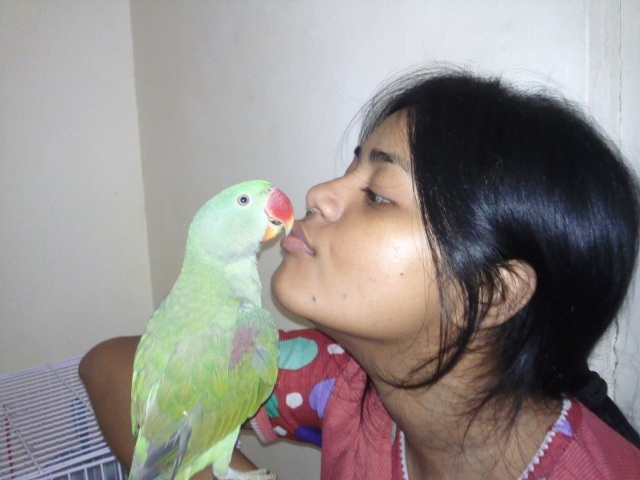 can i give my parrot chole(chana) called in hindi
Question
my little chaddi alexa
dear sir,
can give chan
can i give my parrot chole(chana) called in hindi
Question
my little chaddi alexa
dear sir,
can give chan
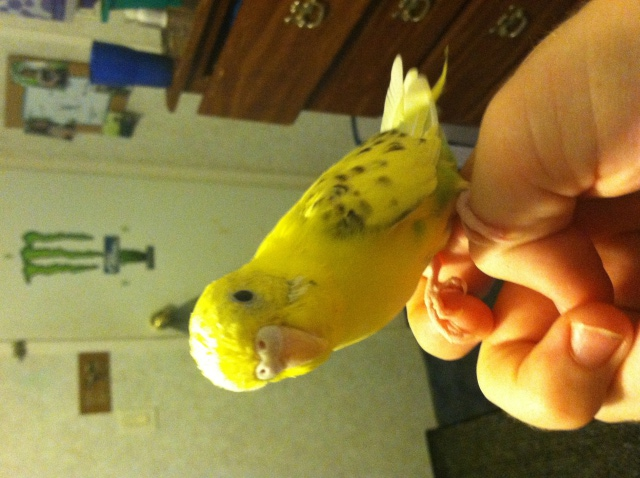 Parakeet gender
Question
Parakeet
Hi, I looked for an expert und
Parakeet gender
Question
Parakeet
Hi, I looked for an expert und
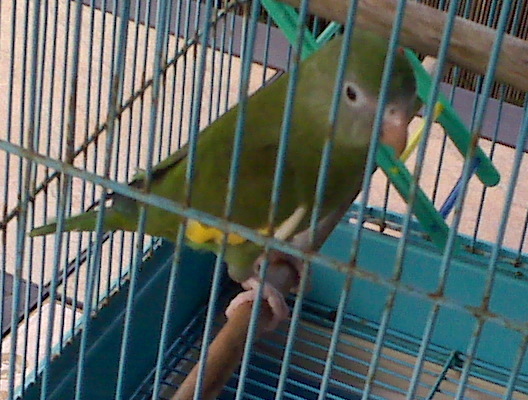 What type of parrot is this?
Question
Friendly bird
A week ago ths small parrot flew
What type of parrot is this?
Question
Friendly bird
A week ago ths small parrot flew